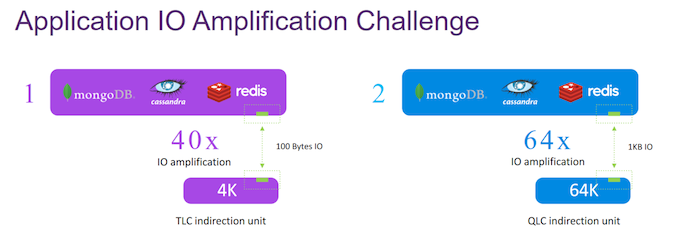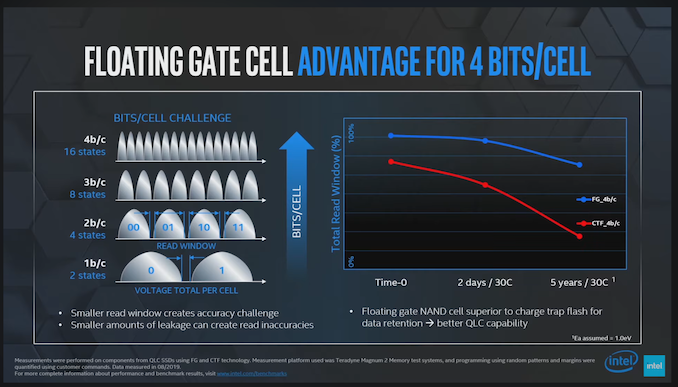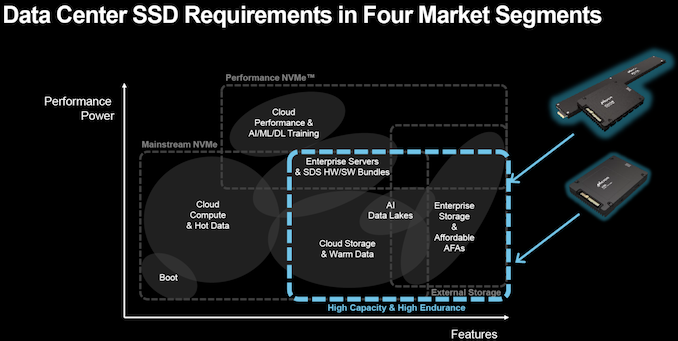Micron Updates Data Center NVMe SSD Lineup: 6500 ION TLC and XTR SLC
by Ganesh T S on May 16, 2023 9:00 AM EST- Posted in
- Storage
- SSDs
- Micron
- Enterprise SSDs

Micron is expanding its data center SSD lineup today with the introduction of two new products - the 6500 ION and the XTR NVMe SSDs. These two products do not fall into any of their existing enterprise SSD lineups. They are meant to fill holes in their product stack for high-capacity and high-endurance offerings.
Micron's competitors have high-density QLC offerings in a variety of form factors for datacenters aiming to maximize the per-rack storage capacity. On the other hand, after the discontinuation of Optane, Micron needed a storage-class memory alternative for write-intensive workloads. Micron's current product stack has offerings for both the mainstream and performance NVMe categories in the form of the 7400 series and 9400 series respectively. The two SSDs being launched today address the high-capacity and high-endurance market segment.
The Micron 6500 ION NVMe SSD addresses the high-capacity aspect. It is a TLC drive with QLC pricing. The Micron XTR NVMe SSD addresses the high endurance aspect. Despite not being a low-latency play, its feature set makes it competitive in many metrics against SCM-class products. A closer look at the specifications and market position of the two SSDs along with a discussion of the competitive landscape follows.
The Micron 6500 ION TLC NVMe SSD
NAND flash technology has evolved rapidly in the last decade or so, with the move from low-density planar SLC to MLC, and then on to TLC. The advent of 3D NAND has now enabled quad-level cells (QLC) that encode up to 4 bits of information in a single cell using 16 different voltage levels. This allows a dramatic increase in capacity for a given die area. QLC comes with its own share of challenges, and is worse than TLC from the viewpoint of almost all metrics - performance, endurance, and power consumption. QLC flash is primarily a cost play for both the consumer and the vendor in the client SSD market. In the enterprise area, cost is one factor, but the more interesting one is rack density. QLC SSDs in the last couple of years have breached the 30TB capacity point at reasonable prices, allowing for a single rack to hold upwards of 1 PB.
Sizing up the Competition...
Micron's QLC play in the enterprise market has been muted. On the other hand, its competitor, Solidigm, has been extremely bullish on QLC for data center use. The Solidigm D5-P5316, in particular, has proved popular from this perspective. A 30TB+ drive in a 2.5" (U.2) form-factor at less than $100/TB has proved to be attractive for data centers to drive up per-rack capacity. As per Solidigm's own marketing material, there is no free lunch. QLC does come with downsides in terms of slow sustained sequential writes (compared to TLC). The D5-P5316 also opted to increase the indirection unit from 4K to 64K. While this allows easier flash management, 4K random writes are greatly impacted due to latency increase from repeated access to the indirection table as well as excessive write amplification. The latter results in very low endurance (in terms of random drive writes per day).

Source: Empowering Real-Time Decision Making for Large-Scale Datasets with SSD-like Economics, SNIA Persistent Memory + Computational Storage Summit, 2022
The Solidigm D5-P5316 can sustain sequential writes (direct to QLC) of just 3.6 GBps, and 4K random write performance is only 7800 IOPS. However, the numbers are more reasonable for 64K random writes because of the indirection table. Solidigm actually suggests adapting the software to avoid 4K random writes, or using the drive only for workloads that are either read-intensive or with large block sequential / random writes. Those types of workloads greatly lower the I/O amplification, this addressing the endurance aspect. Despite these shortcomings, the rack density opportunity was just too good for the data centers to pass up. Micron unfortunately did not have a similarly-priced alternative at that capacity point. That changes today with the 6500 ION.
Avoiding QLC
Micron was the first to ship 3D NAND with 200+ layers, with its 232L generation reaching high-volume manufacturing well ahead of its competitors. The company has been using QLC in the client SSD market for a while now. However, it has been a bit reticent to use it in enterprise SSDs, and the reasons are not difficult to understand. After the dissolution of the IMFT joint development program, Micron and Intel / Solidigm adopted diametrically different flash cell architectures. While Intel / Solidigm continued with floating gate technology, Micron moved on to the charge trap scheme.
Generally speaking, Micron's charge trap flash cell architecture is more suited for TLC. Using it for QLC is more challenging compared to what is possible with Solidigm's floating gate approach.

Source: The Advantages of Floating Gate Technology (YouTube)
Floating gates have lesser charge dispersal issues, and more electrons, allowing for better data accuracy over time - particularly when 16 different voltage levels have to be tracked.
End product cost for high-capacity SSDs is mostly dominated by die cost for the flash. Based on the analysis here, Solidigm's 144L QLC had a bit density of 12.86 Gb/mm2, while Micron's 232L TLC's equivalent number is 14.60 Gb/mm2. With QLC, this number could go even higher. It is possible for Micron to have used 232L QLC to create an even cheaper 30TB SSD compared to the Solidigm D5-P5316, but its specifications in terms of endurance and speeds would have probably been similar to (or worse than) Solidigm offering due to the nature of the flash cell.
Micron decided that a high-capacity 232L TLC SSD could be priced competitively against the 144L Solidigm D5-P5316 QLC offering. This resulted in the development of the Micron 6500 ION NVMe SSD.
Diving into the Details
The key to the Micron 6500 ION's promise of TLC performance at QLC pricing is its NAND fabrication leadership. The company is focusing only on the 30.72 TB capacity point with the 6500 ION. Other capacity points are served well by other products in its stack. The use of TLC means that sequential writes can go as high as 5 GBps, and a 4KB indirection unit ensures random write performance of around 200K IOPS. The lowered write amplification means that the 6500 ION's 4K RDWPD rating of 0.3 is more than 10 times better than the similar number for the Solidigm D5-P5316. Micron claims that TLC SSDs are inherently more power efficient compared to QLC ones, and that does bear out based on the comparison of the datasheet of the D5-P5316 and the new 6500 ION.
| Micron 6500 ION NVMe SSD Specifications | ||
| Aspect | 6500 ION | |
| Form Factor | 2.5" 15mm U.3 or 9.5mm E1.L | |
| Interface, Protocol | PCIe 4.0 x4 NVMe 2.0 | |
| Capacities | 30.72 TB | |
| 3D NAND Flash | Micron 232L Performance TLC | |
| Sequential Performance (GB/s) | 128KB Reads @ QD 128 | 6.8 |
| 128KB Writes @ QD 128 | 5.0 | |
| Random Access (IOPS) | 4KB Reads @ QD 128 | 1M |
| 4KB Writes @ QD 128 | 200K | |
| 4KB 70%R / 30%W @ QD 128 | 400K | |
| Latency (Typical) (us) | 4KB Reads @ QD 1 | 70 |
| 4KB Writes @ QD 1 | 15 | |
| Power Draw (Watts) | 128KB Sequential Read | 15.0 |
| 128KB Sequential Write | 20.0 | |
| 4KB Random Read | 14.0 | |
| 4KB Random Write | 15.0 | |
| Idle | 5.0 | |
| Endurance (DWPD) | 100% 128KB Sequential Writes | 1.0 |
| 90% 128KB Sequential Writes 10% 4KB Random Write |
0.9 | |
| 80% 128KB Sequential Writes 20% 4KB Random Write |
0.85 | |
| 70% 128KB Sequential Writes 30% 4KB Random Write |
0.75 | |
| 50% 128KB Sequential Writes 50% 4KB Random Write |
0.55 | |
| 100% 4KB Random Write | 0.3 | |
| Warranty | 5 years | |
On the business front, the Micron 6500 ION is TAA-compliant and also FIPS 140-3 L2 certifiable. Similar to other enterprise SSDs, the drives carry a 2.5M hour MTTF and a 1 in 1017 uncorrectable bit-error rate.
The Micron 6500 ION SSD brings a compelling option to data center customers who have adopted the Solidigm D5-P5316 or actively considered adopting it. However, Solidigm has not been idle either. At last year's Tech Field Day, the company had talked about using its 192L QLC technology to create 30TB SSDs with 4KB IUs. So, the challenger for the 6500 ION in the market will be those drives, rather than the Solidigm D5-P5316.
Before moving on to the XTR NVMe SCM competitor, a note on RAID rebuild times with 30TB SSDs is warranted. One of the vexing issues with high-capacity HDDs is RAID rebuild with parity computation and writing, with the process being bottlenecked by the SATA interface. Thankfully, the PCIe 4.0 x4 NVMe interface with sequential speeds approaching 6.8 GBps reads and 5 GBps writes, can easily handle that even when servicing other data workloads. Even when operated in a cluster spread over multiple physical machines, usage of a 50 GbE or faster network backbone can enable this resiliency with minimal performance impact.











7 Comments
View All Comments
LiKenun - Sunday, May 21, 2023 - link
The latency doesn’t come near Optane, but the endurance of the SLC is pretty impressive. The P4800X is “just” twice the endurance at 60 DWPD. The P5800X has the SLC offering beat on capacity though; it’s got a 3.2 TB capacity while Micron’s SLC tops out at 1.92 TB.Silver5urfer - Sunday, May 21, 2023 - link
Unfortunately, It's all in vain for the even enthusiast consumer.M.2 2280 is a poorly designed interface. The size is too small to scale, and Enterprise almost never uses them, which is why most of the NVMe drives are using 2.5" U.2 or U.3 form factor which is literally Universal across all the Enterprise SSDs. Look at Optane P4800X and P5800X same. Enterprise Samsung SSD PM1733 SSD also same it has 30TB of space, yes it its unobtainium class of price but still there are many U.2 SSDs to buy but consumers are out of options, you have to use an NVMe to U.2 adapters and I doubt they can be seamless.
Plus except EVGA nobody offers U.2, tbh if I want an Extreme board from ASUS or Gigabyte or Godlike from MSI etc, they should have this U.2 connectors esp with the tons of PCIe 4.0 and 5.0 lanes now coming from modern x86 Intel and AMD processors.
If you look at SATA SSDs, I bet all of the consumers forgot them as outdated. IRL the Enterprise still uses the SATA 2.5" SSDs and guess what ? They blow the lid off the NVMe M.2 in sheer Endurance and Capacity as well.
In NVMe M.2 we also have the Controller / Firmware QC problems, look at Seagate 530 tons of failures, SN850 and X both have boot detection problems, Samsung 980 Pro and 990 Pro premature SSD wear. And these also have issues on Unraid, etc Homelab implementation. It's like they cared a bit on the controllers and threw a bunch of benchmarks and people became suckers on them. Oh also how many users do a post pseudo SLC cache write test ? They do not even know rofl, 90% of the users do not even know. They just think DirectX storage is the only thing they are buying these SSDs for not the high speed or consistency or the endurance.
erotomania - Wednesday, May 24, 2023 - link
90% of users buy M.2 NVMe drives for "DirectX storage"? I think that perspective is warped.Kamen Rider Blade - Monday, May 29, 2023 - link
I 100% concur, M.2 is a poor interface for the desktop / server environment.I believe that the obsolete 1.8 HDD format should be brought back from the dead and re-used as a dedicated SSD format with 5 mm thick 1.8" SSD/HDD format for Consumer and 8mm thick 1.8" SSD/HDD format for Enterprise to allow for some Heat Sink fins.
U.3 / U.2 connector FTW, it's so much more durable.
The M.2 connector is only designed for 50 Mating Cycles.
The SATA/SAS/U.2/U.3 connector is designed for 10,000 Mating Cycles.
There's a WORLD of difference for durability.
Let's leave M.2 as a Mobile Product ONLY solution.
Every-where else, let's all move to U.3 & 1.8" SSD/HDD format please.
zepi - Thursday, June 1, 2023 - link
M.2 is perfectly good form factor for server boot drives.xane - Monday, May 22, 2023 - link
I rarely, if ever use TLC, always go the extra mile to get MLC. QLC is a far cry to me, though I understand that decision to purchase these is often dictated by one's wallet, so I respect it. Solidigm went South with their lineup in my opinion. I have had Intel MLC drives for so long, none has failed yet (knock on wood lol).erotomania - Wednesday, May 24, 2023 - link
I briefly tried out two Solidigm P41 Plus SSDs. They were returned - the experience was similar to SMR HDDs. The only thing predictable was that they were unpredictably slow.